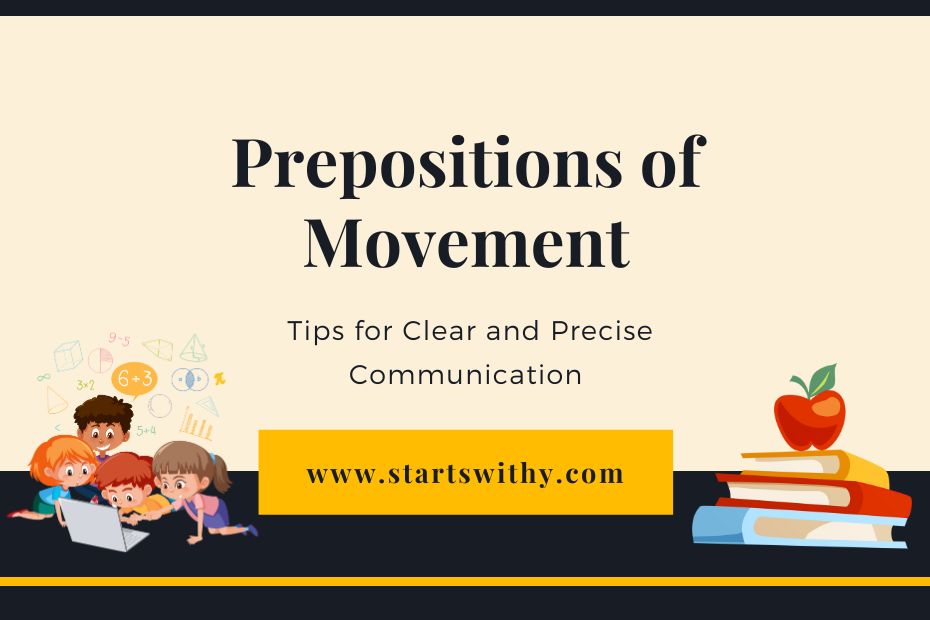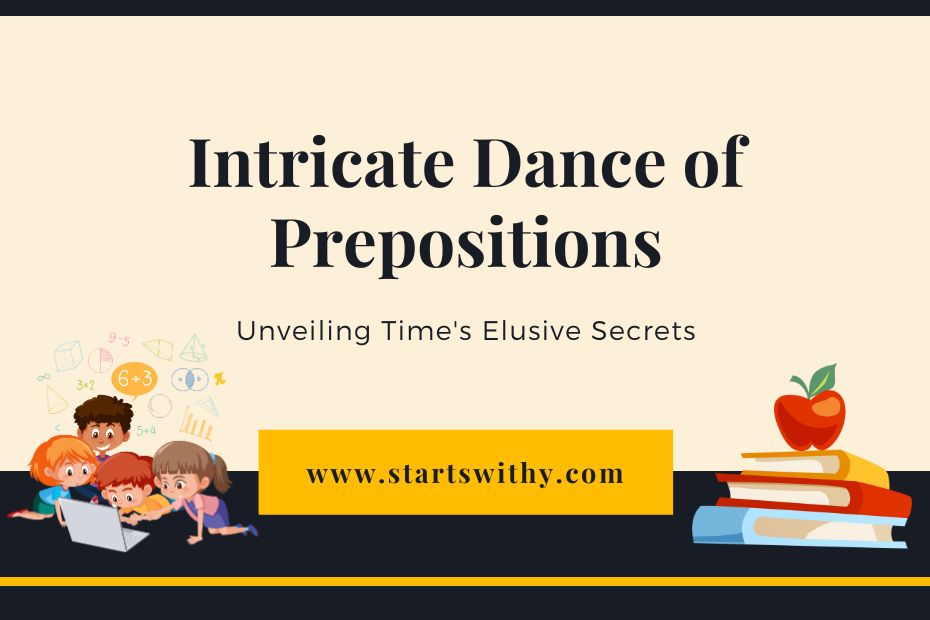Are you ready to take your English language skills to the next level? In this article, we will explore the fascinating world of prepositions of movement. These little words play a big role in describing how we move from one place to another. Whether you’re walking, running, or driving, prepositions of movement help us express the direction and displacement of our actions.
Have you ever wondered how to properly use prepositions like “to,” “from,” or “into” when talking about movement? Well, you’re in the right place! In this article, we will dive deep into the world of prepositions of movement and discover how they can enhance your English language skills. From expressing the direction of travel to indicating the destination, prepositions of movement are essential in conveying clear and accurate information. So, let’s get started and unlock the secrets of these powerful words that guide our movements.
Prepositions of Movement
When it comes to expressing movement in English, prepositions play a crucial role. Prepositions of movement are used to describe the direction and displacement of actions from one place to another. Whether we are talking about going to work, driving to a city, or attending a party, these prepositions help convey clear and accurate information about how we move and where we are headed.
The most common preposition of movement is “to”, which describes movement in the direction of something. For example, we can ask, “How do you go to work?” or say, “He drove to London in five hours.” This preposition indicates that the action is moving towards a particular destination.
In addition to “to”, there are several other prepositions of movement that are frequently used in English:
- “From” indicates movement away from a place. For instance, we might say, “She walked from the kitchen to the living room.”
- “Into” shows movement towards the inside of something. We can use it to describe actions like “He jumped into the pool” or “She went into the building.”
- “Out of” describes movement away from the inside of something. For example, “They ran out of the store” or “I stepped out of the car.”
- “Onto” indicates moving onto a surface or object. We might say, “She climbed onto the roof” or “He jumped onto the bed.”
- “Off” signifies moving away from a surface or object. For instance, “He got off the bus” or “She walked off the stage.”
Remember, prepositions of movement are always used in conjunction with verbs of motion. By using them correctly, we can provide precise information about travel directions and destinations. So practice incorporating them into your English language skills, and soon you’ll navigate conversations about movement like a pro.
Now that we’ve explored prepositions of movement, it’s time to delve into another important aspect of English grammar. Let’s take a closer look at prepositions of place and how they enhance the way we describe locations.
Introduction
Prepositions of movement play a crucial role in the English language when it comes to describing how we move from one place to another. These prepositions are essential for conveying clear and accurate information about travel direction and destination. In this section, I will delve into what prepositions of movement are and why they are important in our everyday language.
What are prepositions of movement?
Prepositions of movement are words that describe the movement of objects or people from one place to another. They help us specify the direction of movement, the starting point, and the destination. Some common prepositions of movement include “to,” “from,” “through,” “into,” and “out of.” We usually use these prepositions in conjunction with verbs of motion, such as “go,” “walk,” and “run.”
These prepositions provide essential information about how an action is performed and where it is directed. For example, “He walked to the store” indicates the direction of the movement, while “She ran out of the room” specifies the starting point. By using prepositions of movement, we can accurately describe and understand the dynamics of various movements.
Why are prepositions of movement important?
Using prepositions of movement correctly is crucial because it helps us avoid confusion and misunderstandings. Imagine saying, “I am going to the store” instead of “I am going into the store.” The choice of the preposition “into” clarifies that you are entering the store, not just heading towards it. Using the wrong preposition can lead to ambiguous communication and misinterpretation.
By utilizing prepositions of movement appropriately, we can make our meaning clear and ensure that others understand our intended message. Whether it’s indicating direction, specifying the starting point, or describing the destination, prepositions of movement provide the necessary context to communicate our intentions accurately.
In the following sections, I will explore the different types of prepositions of movement and provide examples to help you grasp their usage effectively. So, let’s dive in and discover the intricacies of these essential components of English grammar.
Types of Prepositions of Movement
Prepositions indicating direction
When it comes to describing movement, prepositions indicating direction are crucial. These prepositions help us specify the path or route taken by a person or object. Here are some common prepositions that indicate direction:
- To: This preposition is used to indicate movement towards a specific destination or goal. For example, “She walked to the store” implies that someone is moving towards the store.
- From: “From” is used to describe movement away from a specific place or origin. For instance, “He traveled from New York to Los Angeles” suggests that someone is moving away from New York towards Los Angeles.
- Into: When something or someone is entering a space or container, we use the preposition “into.” For example, “She jumped into the swimming pool” implies that someone is moving into the swimming pool.
- Out of: The opposite of “into,” the preposition “out of” signifies movement out of a space or container. For instance, “The cat climbed out of the box” indicates that the cat is moving out of the box.
Prepositions indicating destination
Prepositions indicating destination help us convey the endpoint or target of a particular movement. These prepositions specify the place where someone or something is headed. Here are a few examples:
- To: As mentioned earlier, “to” is commonly used to indicate the direction of movement. It signifies movement towards a specific destination. For instance, “I am going to the store” suggests that the person is heading towards the store.
- Towards: Similar to “to,” the preposition “towards” indicates movement in the direction of a particular destination. For example, “She pushed her face towards him” implies that she moved her face in his direction.
Prepositions indicating time and manner
In addition to indicating direction and destination, prepositions of movement can also convey information about time and manner. These prepositions help us describe how someone or something is moving. Here are a couple of examples:
- Along: The preposition “along” indicates movement in a continuous line or direction. For instance, “We strolled along the beach” suggests that we were moving in a straight line parallel to the beach.
- Through: “Through” signifies movement from one side to another, often across a surface or barrier. For example, “They swam through the river” implies that they moved from one side of the river to the other.
These prepositions of movement not only enhance the clarity of our communication but also add depth and detail to our sentences. By using them correctly, we can effectively describe the movement of objects and people, making our language more precise and engaging.
Examples of Prepositions of Movement
Prepositions indicating direction
When it comes to indicating the direction of movement, prepositions play a crucial role in English grammar. They help us specify the path or route taken by a person or object. Here are some examples of prepositions indicating direction:
- To: We use “to” to describe movement in the direction of something or someone. For example, “I am going to the store” means that you are moving towards the store.
- From: “From” is used to describe movement away from something or someone. For instance, “I am coming from the store” means that you are moving away from the store.
- Across: “Across” is used to describe movement from one side of an area, surface, or line to the other side. For example, “I drew a line across the paper” means that you drew a line from one side of the paper to the other.
Prepositions indicating destination
Another important aspect of movement is indicating the destination or the place where someone or something is headed. Using the right prepositions is crucial for clear and accurate communication. Here are some examples of prepositions indicating destination:
- To: The most common preposition of movement is “to.” It is used to describe movement in the direction of a specific destination or goal. For example, “She walked to the store” or “The plane is flying to Paris.”
- Toward: “Toward” is also used to describe movement in the direction of something. For instance, “We walked toward the beach.”
- Into: When something is entering or moving inside a space or container, we use the preposition “into.” For example, “She jumped into the swimming pool” or “He put the groceries into the bag.”
Prepositions indicating time and manner
Prepositions of movement can also convey information about time and manner. They add depth and clarity to our sentences. Here are some examples of prepositions indicating time and manner:
- Along: “Along” indicates movement in a continuous line or direction. For instance, “We strolled along the beach” or “The train moved along the tracks.”
- Through: “Through” signifies movement from one side of something to the other. It is often used when passing through a space or barrier. For example, “We walked through the park to get to the other side” or “The runners sprinted through the finish line.”
- Across: Similar to “through,” “across” is used to describe movement from one side to another. However, it implies that the distance is greater than “through.” For instance, “We swam across the lake” or “She walked across the bridge.”
By understanding and using these prepositions correctly, you can enhance the clarity and precision of your communication. Remember to consider the intended direction, destination, time, and manner when choosing the appropriate preposition of movement.
Tips for Using Prepositions of Movement Correctly
Tips for Using Prepositions of Movement Correctly
Understand the context
When using prepositions of movement, it’s important to understand the context in which they are used. This means paying attention to the direction, starting point, and destination of the movement being described. By understanding the context, you can choose the correct preposition that fits the situation and conveys your intended meaning clearly.
For example, if you are talking about going to a location, you would use the preposition “to” to indicate the direction towards the destination. On the other hand, if you want to describe movement within a space, you would use the preposition “through” to convey the idea of movement within an enclosed area.
Practice with exercises
One of the best ways to improve your understanding and usage of prepositions of movement is through practice. By engaging in exercises that involve filling in the blanks or matching sentences to corresponding pictures, you can reinforce your knowledge and develop a better grasp of how these prepositions function in different scenarios.
Here’s an exercise for you to try:
Exercise 1: Fill in the Blanks
Complete the following sentences with the correct preposition of movement:
- I walked down the street to get to the store.
- The bird flew from the tree and landed on the ground.
- We drove across the mountain to reach the cabin.
- The cat jumped off the couch and onto the floor.
- She climbed up the ladder to reach the roof.
Use prepositions of movement in everyday situations
Once you have a good understanding of prepositions of movement and have practiced using them in exercises, it’s important to apply your knowledge to everyday situations. By consciously using these prepositions in your writing and speech, you can enhance the clarity and precision of your communication.
For instance, instead of saying “I went to the store,” you can say “I went into the store” to indicate that you physically entered the establishment. Similarly, if you want to describe someone walking towards you, you can say “He was walking towards me” to convey the direction of the movement.
By incorporating prepositions of movement into your everyday language, you’ll develop a natural fluency in using them correctly and effectively.
Remember, understanding the context, practicing with exercises, and using prepositions of movement in everyday situations will help you master their usage and improve the clarity and precision of your communication. So keep practicing, stay observant, and soon it will become second nature to you.
Conclusion
Mastering prepositions of movement is crucial for effective communication in English. By understanding the context, practicing with exercises, and incorporating these prepositions into everyday situations, you can enhance the clarity and precision of your language.
Prepositions of movement, such as “to,” “from,” “through,” and “across,” help convey direction and movement in a sentence. They provide essential information about how people and objects move from one place to another.
Remember to pay attention to the specific preposition that accurately describes the movement you want to convey. This will ensure that your message is clear and easily understood by your audience.
By consistently using prepositions of movement correctly, you will demonstrate a strong command of the English language and improve your overall communication skills. So, keep practicing and incorporating these prepositions into your daily conversations, and you’ll soon become a master of expressing movement in English.



